Business Decision Making: NPV vs Payback Period
VerifiedAdded on 2023/06/05
|8
|1275
|383
AI Summary
This essay discusses the decision-making process for investment in the production of clothes and leather bags by S&P, a UK-based company. It compares the key aspects of NPV and payback period and highlights non-financial and financial factors affecting the decision-making process. The essay concludes that the company should invest in Project A based on NPV.
Contribute Materials
Your contribution can guide someone’s learning journey. Share your
documents today.

BUSINESS DECISION
MAKING
MAKING
Secure Best Marks with AI Grader
Need help grading? Try our AI Grader for instant feedback on your assignments.
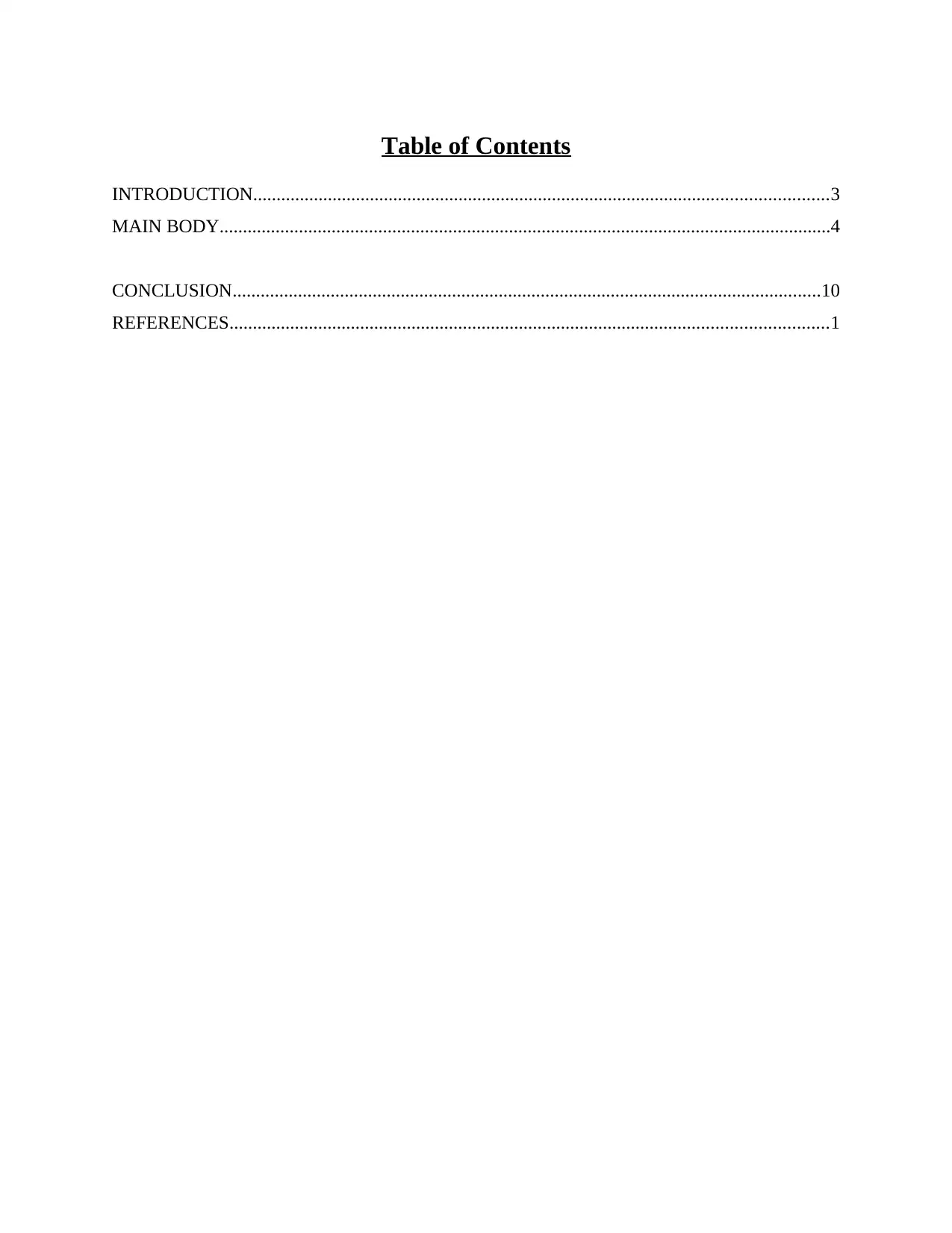
Table of Contents
INTRODUCTION...........................................................................................................................3
MAIN BODY...................................................................................................................................4
CONCLUSION..............................................................................................................................10
REFERENCES................................................................................................................................1
INTRODUCTION...........................................................................................................................3
MAIN BODY...................................................................................................................................4
CONCLUSION..............................................................................................................................10
REFERENCES................................................................................................................................1
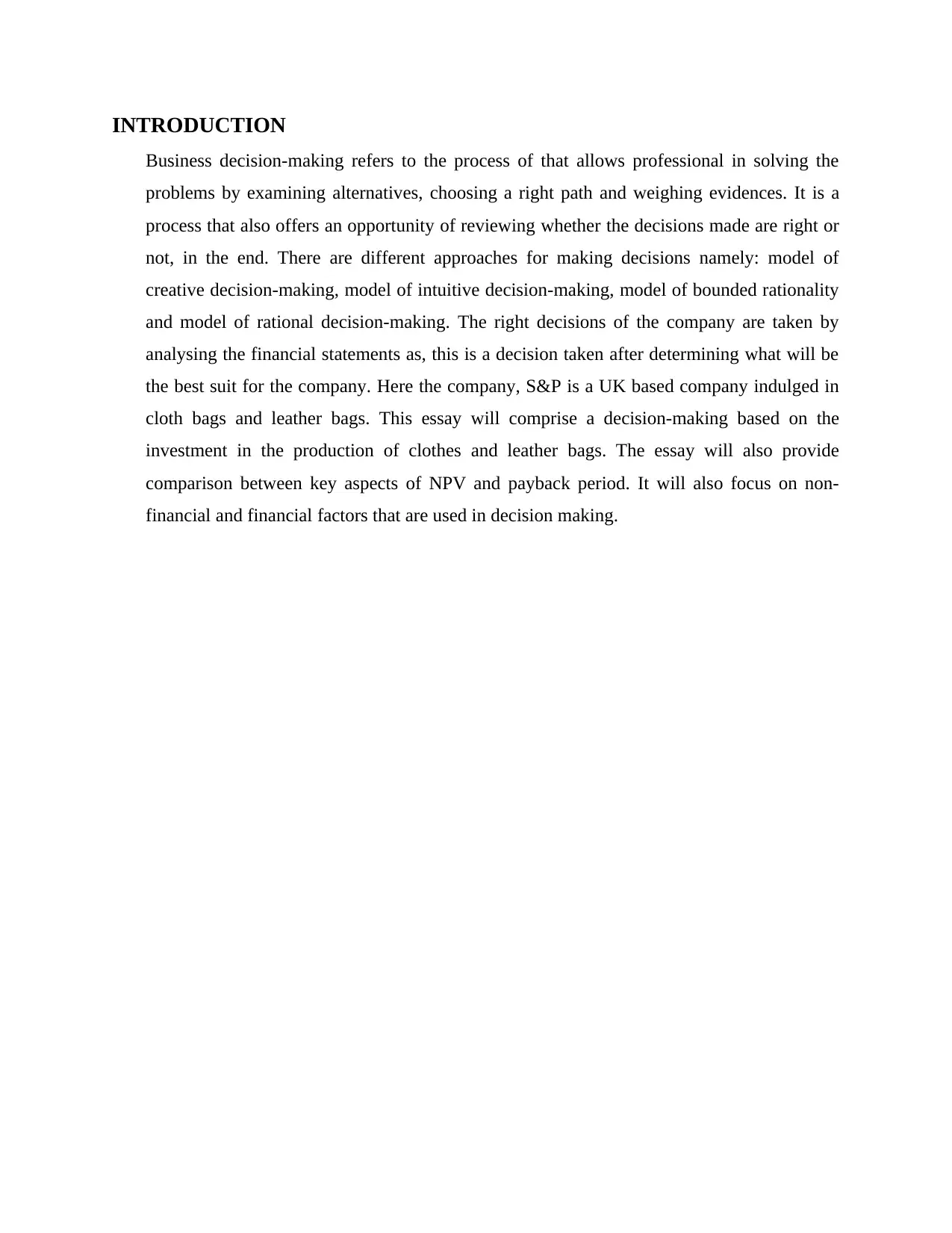
INTRODUCTION
Business decision-making refers to the process of that allows professional in solving the
problems by examining alternatives, choosing a right path and weighing evidences. It is a
process that also offers an opportunity of reviewing whether the decisions made are right or
not, in the end. There are different approaches for making decisions namely: model of
creative decision-making, model of intuitive decision-making, model of bounded rationality
and model of rational decision-making. The right decisions of the company are taken by
analysing the financial statements as, this is a decision taken after determining what will be
the best suit for the company. Here the company, S&P is a UK based company indulged in
cloth bags and leather bags. This essay will comprise a decision-making based on the
investment in the production of clothes and leather bags. The essay will also provide
comparison between key aspects of NPV and payback period. It will also focus on non-
financial and financial factors that are used in decision making.
Business decision-making refers to the process of that allows professional in solving the
problems by examining alternatives, choosing a right path and weighing evidences. It is a
process that also offers an opportunity of reviewing whether the decisions made are right or
not, in the end. There are different approaches for making decisions namely: model of
creative decision-making, model of intuitive decision-making, model of bounded rationality
and model of rational decision-making. The right decisions of the company are taken by
analysing the financial statements as, this is a decision taken after determining what will be
the best suit for the company. Here the company, S&P is a UK based company indulged in
cloth bags and leather bags. This essay will comprise a decision-making based on the
investment in the production of clothes and leather bags. The essay will also provide
comparison between key aspects of NPV and payback period. It will also focus on non-
financial and financial factors that are used in decision making.
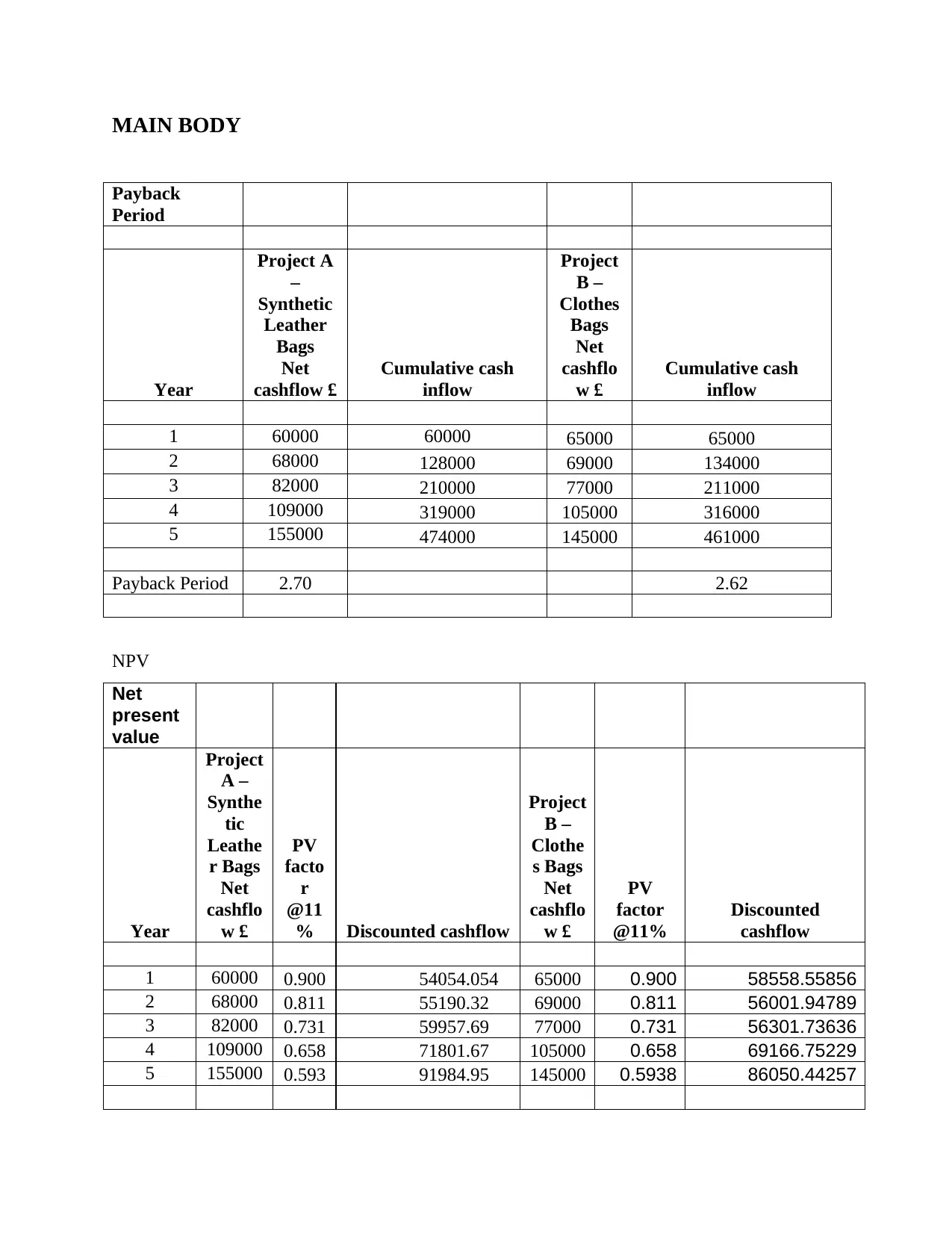
MAIN BODY
Payback
Period
Year
Project A
–
Synthetic
Leather
Bags
Net
cashflow £
Cumulative cash
inflow
Project
B –
Clothes
Bags
Net
cashflo
w £
Cumulative cash
inflow
1 60000 60000 65000 65000
2 68000 128000 69000 134000
3 82000 210000 77000 211000
4 109000 319000 105000 316000
5 155000 474000 145000 461000
Payback Period 2.70 2.62
NPV
Net
present
value
Year
Project
A –
Synthe
tic
Leathe
r Bags
Net
cashflo
w £
PV
facto
r
@11
% Discounted cashflow
Project
B –
Clothe
s Bags
Net
cashflo
w £
PV
factor
@11%
Discounted
cashflow
1 60000 0.900 54054.054 65000 0.900 58558.55856
2 68000 0.811 55190.32 69000 0.811 56001.94789
3 82000 0.731 59957.69 77000 0.731 56301.73636
4 109000 0.658 71801.67 105000 0.658 69166.75229
5 155000 0.593 91984.95 145000 0.5938 86050.44257
Payback
Period
Year
Project A
–
Synthetic
Leather
Bags
Net
cashflow £
Cumulative cash
inflow
Project
B –
Clothes
Bags
Net
cashflo
w £
Cumulative cash
inflow
1 60000 60000 65000 65000
2 68000 128000 69000 134000
3 82000 210000 77000 211000
4 109000 319000 105000 316000
5 155000 474000 145000 461000
Payback Period 2.70 2.62
NPV
Net
present
value
Year
Project
A –
Synthe
tic
Leathe
r Bags
Net
cashflo
w £
PV
facto
r
@11
% Discounted cashflow
Project
B –
Clothe
s Bags
Net
cashflo
w £
PV
factor
@11%
Discounted
cashflow
1 60000 0.900 54054.054 65000 0.900 58558.55856
2 68000 0.811 55190.32 69000 0.811 56001.94789
3 82000 0.731 59957.69 77000 0.731 56301.73636
4 109000 0.658 71801.67 105000 0.658 69166.75229
5 155000 0.593 91984.95 145000 0.5938 86050.44257
Secure Best Marks with AI Grader
Need help grading? Try our AI Grader for instant feedback on your assignments.
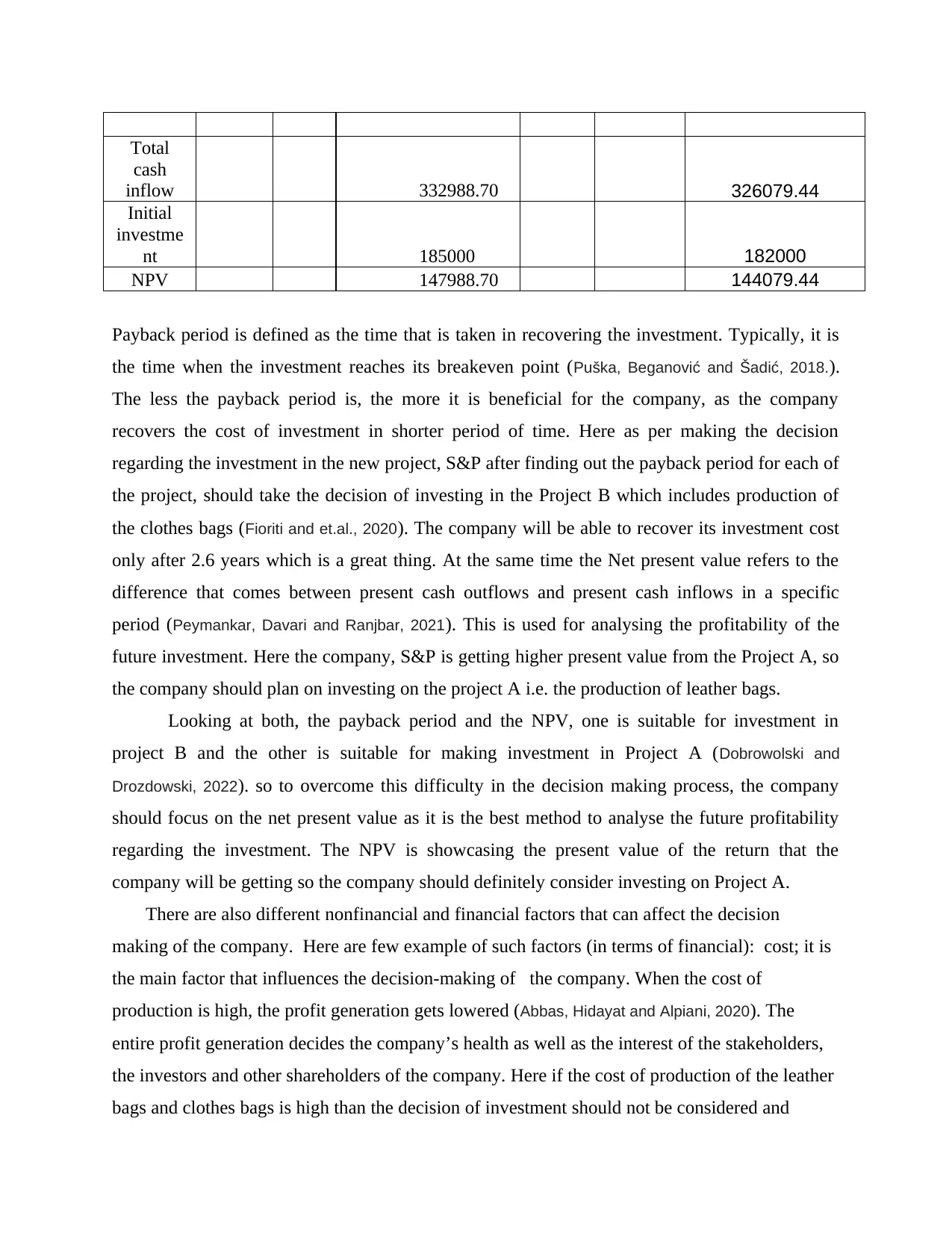
Total
cash
inflow 332988.70 326079.44
Initial
investme
nt 185000 182000
NPV 147988.70 144079.44
Payback period is defined as the time that is taken in recovering the investment. Typically, it is
the time when the investment reaches its breakeven point (Puška, Beganović and Šadić, 2018.).
The less the payback period is, the more it is beneficial for the company, as the company
recovers the cost of investment in shorter period of time. Here as per making the decision
regarding the investment in the new project, S&P after finding out the payback period for each of
the project, should take the decision of investing in the Project B which includes production of
the clothes bags (Fioriti and et.al., 2020). The company will be able to recover its investment cost
only after 2.6 years which is a great thing. At the same time the Net present value refers to the
difference that comes between present cash outflows and present cash inflows in a specific
period (Peymankar, Davari and Ranjbar, 2021). This is used for analysing the profitability of the
future investment. Here the company, S&P is getting higher present value from the Project A, so
the company should plan on investing on the project A i.e. the production of leather bags.
Looking at both, the payback period and the NPV, one is suitable for investment in
project B and the other is suitable for making investment in Project A (Dobrowolski and
Drozdowski, 2022). so to overcome this difficulty in the decision making process, the company
should focus on the net present value as it is the best method to analyse the future profitability
regarding the investment. The NPV is showcasing the present value of the return that the
company will be getting so the company should definitely consider investing on Project A.
There are also different nonfinancial and financial factors that can affect the decision
making of the company. Here are few example of such factors (in terms of financial): cost; it is
the main factor that influences the decision-making of the company. When the cost of
production is high, the profit generation gets lowered (Abbas, Hidayat and Alpiani, 2020). The
entire profit generation decides the company’s health as well as the interest of the stakeholders,
the investors and other shareholders of the company. Here if the cost of production of the leather
bags and clothes bags is high than the decision of investment should not be considered and
cash
inflow 332988.70 326079.44
Initial
investme
nt 185000 182000
NPV 147988.70 144079.44
Payback period is defined as the time that is taken in recovering the investment. Typically, it is
the time when the investment reaches its breakeven point (Puška, Beganović and Šadić, 2018.).
The less the payback period is, the more it is beneficial for the company, as the company
recovers the cost of investment in shorter period of time. Here as per making the decision
regarding the investment in the new project, S&P after finding out the payback period for each of
the project, should take the decision of investing in the Project B which includes production of
the clothes bags (Fioriti and et.al., 2020). The company will be able to recover its investment cost
only after 2.6 years which is a great thing. At the same time the Net present value refers to the
difference that comes between present cash outflows and present cash inflows in a specific
period (Peymankar, Davari and Ranjbar, 2021). This is used for analysing the profitability of the
future investment. Here the company, S&P is getting higher present value from the Project A, so
the company should plan on investing on the project A i.e. the production of leather bags.
Looking at both, the payback period and the NPV, one is suitable for investment in
project B and the other is suitable for making investment in Project A (Dobrowolski and
Drozdowski, 2022). so to overcome this difficulty in the decision making process, the company
should focus on the net present value as it is the best method to analyse the future profitability
regarding the investment. The NPV is showcasing the present value of the return that the
company will be getting so the company should definitely consider investing on Project A.
There are also different nonfinancial and financial factors that can affect the decision
making of the company. Here are few example of such factors (in terms of financial): cost; it is
the main factor that influences the decision-making of the company. When the cost of
production is high, the profit generation gets lowered (Abbas, Hidayat and Alpiani, 2020). The
entire profit generation decides the company’s health as well as the interest of the stakeholders,
the investors and other shareholders of the company. Here if the cost of production of the leather
bags and clothes bags is high than the decision of investment should not be considered and
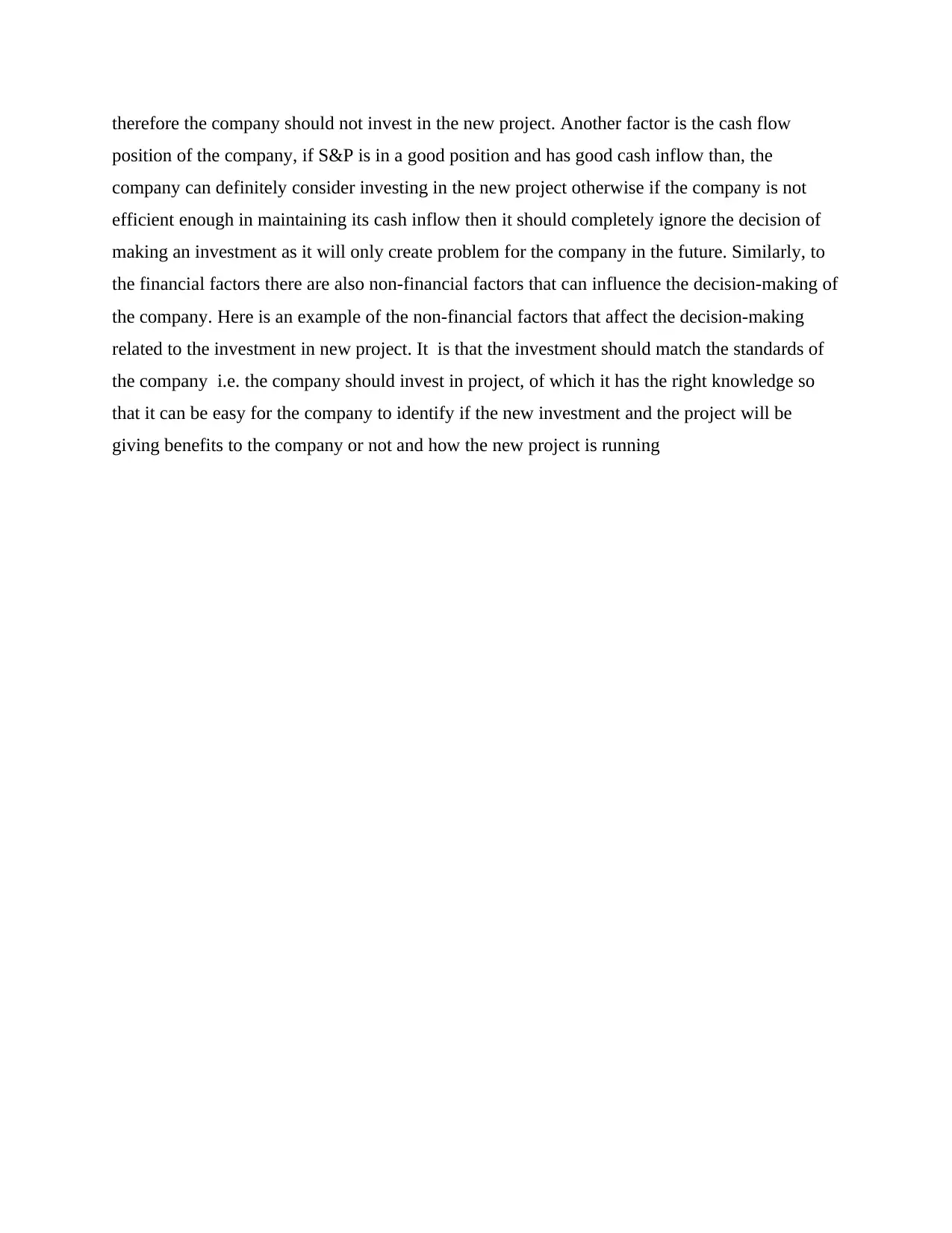
therefore the company should not invest in the new project. Another factor is the cash flow
position of the company, if S&P is in a good position and has good cash inflow than, the
company can definitely consider investing in the new project otherwise if the company is not
efficient enough in maintaining its cash inflow then it should completely ignore the decision of
making an investment as it will only create problem for the company in the future. Similarly, to
the financial factors there are also non-financial factors that can influence the decision-making of
the company. Here is an example of the non-financial factors that affect the decision-making
related to the investment in new project. It is that the investment should match the standards of
the company i.e. the company should invest in project, of which it has the right knowledge so
that it can be easy for the company to identify if the new investment and the project will be
giving benefits to the company or not and how the new project is running
position of the company, if S&P is in a good position and has good cash inflow than, the
company can definitely consider investing in the new project otherwise if the company is not
efficient enough in maintaining its cash inflow then it should completely ignore the decision of
making an investment as it will only create problem for the company in the future. Similarly, to
the financial factors there are also non-financial factors that can influence the decision-making of
the company. Here is an example of the non-financial factors that affect the decision-making
related to the investment in new project. It is that the investment should match the standards of
the company i.e. the company should invest in project, of which it has the right knowledge so
that it can be easy for the company to identify if the new investment and the project will be
giving benefits to the company or not and how the new project is running
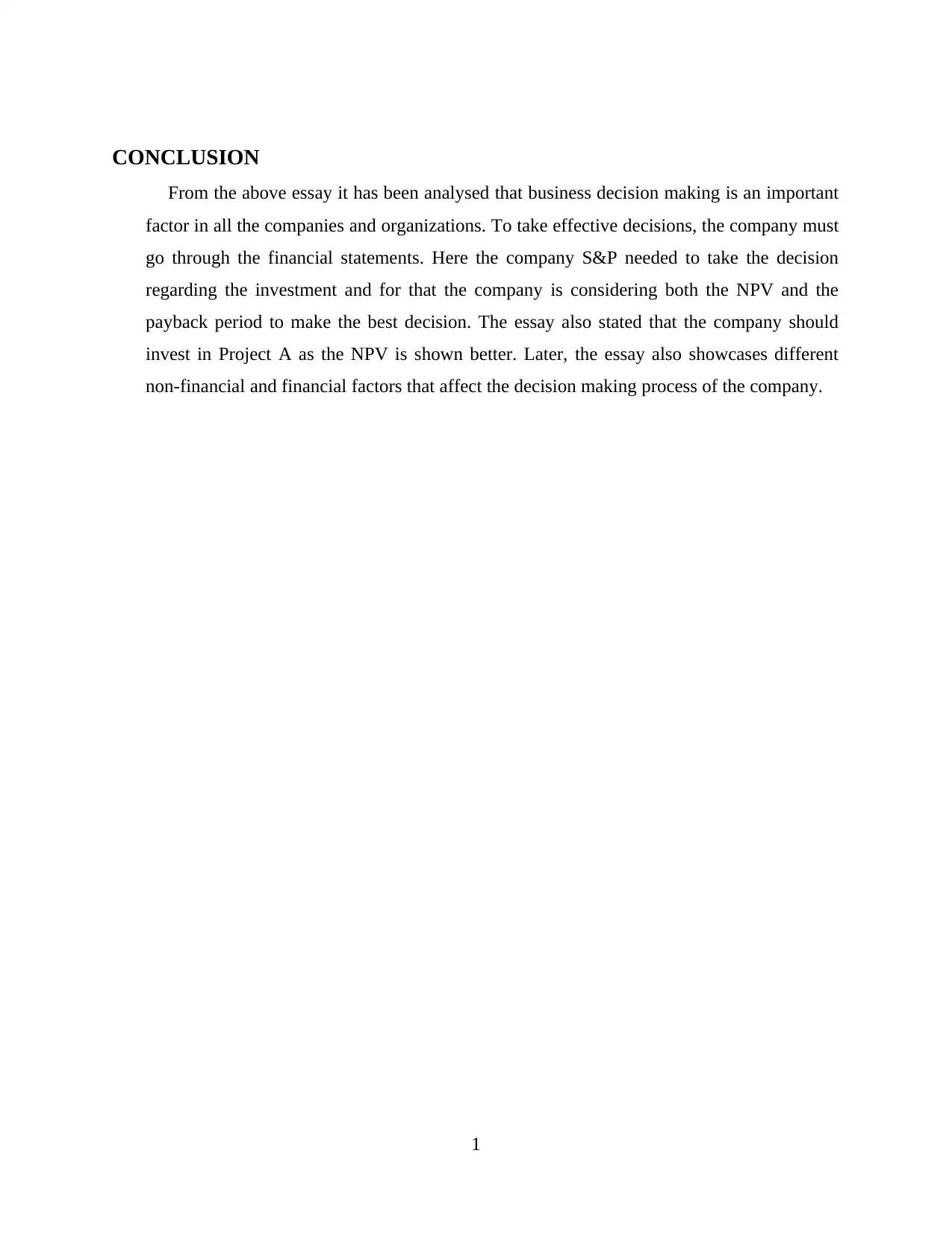
CONCLUSION
From the above essay it has been analysed that business decision making is an important
factor in all the companies and organizations. To take effective decisions, the company must
go through the financial statements. Here the company S&P needed to take the decision
regarding the investment and for that the company is considering both the NPV and the
payback period to make the best decision. The essay also stated that the company should
invest in Project A as the NPV is shown better. Later, the essay also showcases different
non-financial and financial factors that affect the decision making process of the company.
1
From the above essay it has been analysed that business decision making is an important
factor in all the companies and organizations. To take effective decisions, the company must
go through the financial statements. Here the company S&P needed to take the decision
regarding the investment and for that the company is considering both the NPV and the
payback period to make the best decision. The essay also stated that the company should
invest in Project A as the NPV is shown better. Later, the essay also showcases different
non-financial and financial factors that affect the decision making process of the company.
1
Paraphrase This Document
Need a fresh take? Get an instant paraphrase of this document with our AI Paraphraser
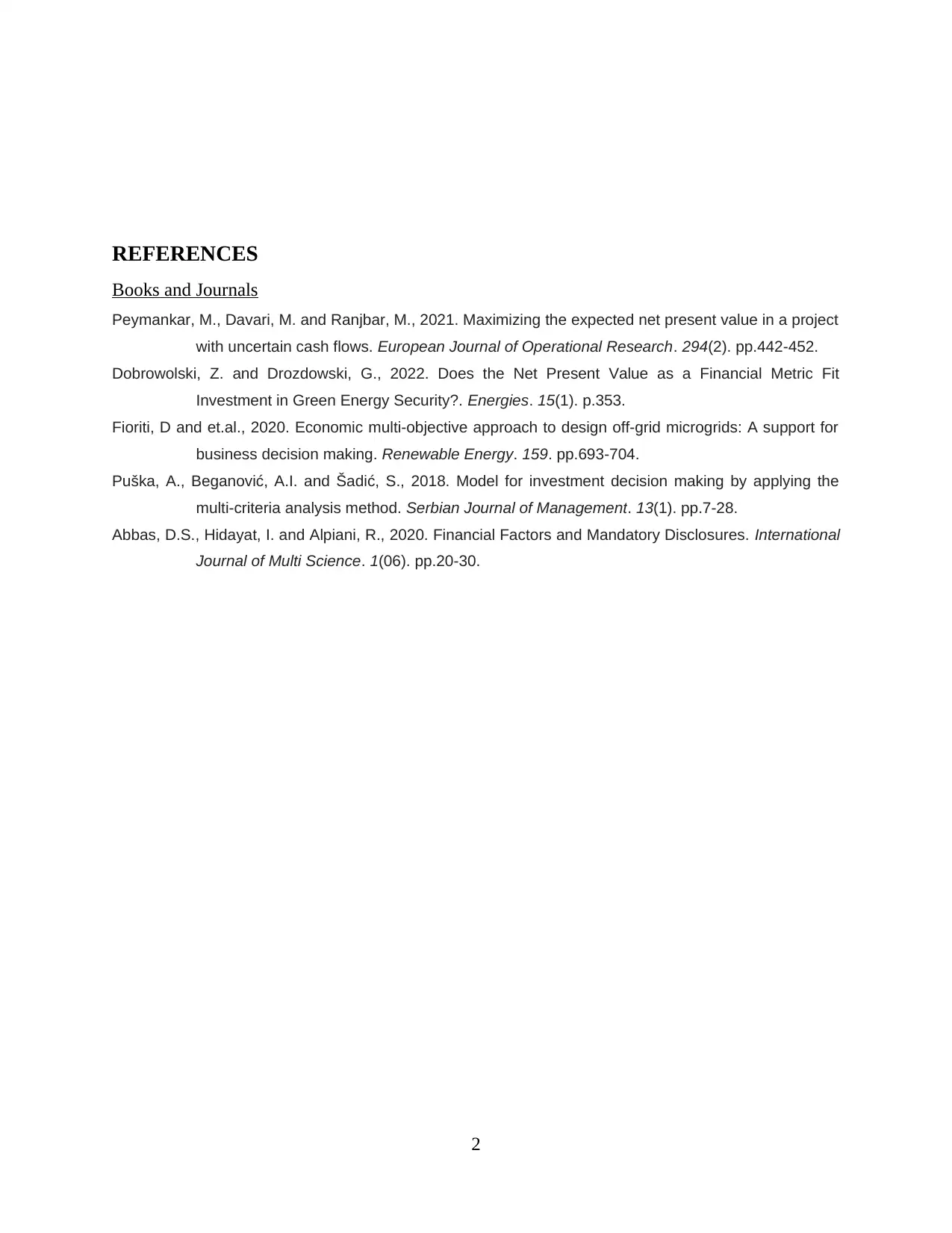
REFERENCES
Books and Journals
Peymankar, M., Davari, M. and Ranjbar, M., 2021. Maximizing the expected net present value in a project
with uncertain cash flows. European Journal of Operational Research. 294(2). pp.442-452.
Dobrowolski, Z. and Drozdowski, G., 2022. Does the Net Present Value as a Financial Metric Fit
Investment in Green Energy Security?. Energies. 15(1). p.353.
Fioriti, D and et.al., 2020. Economic multi-objective approach to design off-grid microgrids: A support for
business decision making. Renewable Energy. 159. pp.693-704.
Puška, A., Beganović, A.I. and Šadić, S., 2018. Model for investment decision making by applying the
multi-criteria analysis method. Serbian Journal of Management. 13(1). pp.7-28.
Abbas, D.S., Hidayat, I. and Alpiani, R., 2020. Financial Factors and Mandatory Disclosures. International
Journal of Multi Science. 1(06). pp.20-30.
2
Books and Journals
Peymankar, M., Davari, M. and Ranjbar, M., 2021. Maximizing the expected net present value in a project
with uncertain cash flows. European Journal of Operational Research. 294(2). pp.442-452.
Dobrowolski, Z. and Drozdowski, G., 2022. Does the Net Present Value as a Financial Metric Fit
Investment in Green Energy Security?. Energies. 15(1). p.353.
Fioriti, D and et.al., 2020. Economic multi-objective approach to design off-grid microgrids: A support for
business decision making. Renewable Energy. 159. pp.693-704.
Puška, A., Beganović, A.I. and Šadić, S., 2018. Model for investment decision making by applying the
multi-criteria analysis method. Serbian Journal of Management. 13(1). pp.7-28.
Abbas, D.S., Hidayat, I. and Alpiani, R., 2020. Financial Factors and Mandatory Disclosures. International
Journal of Multi Science. 1(06). pp.20-30.
2
1 out of 8
Related Documents
Your All-in-One AI-Powered Toolkit for Academic Success.
+13062052269
info@desklib.com
Available 24*7 on WhatsApp / Email
![[object Object]](/_next/static/media/star-bottom.7253800d.svg)
Unlock your academic potential
© 2024 | Zucol Services PVT LTD | All rights reserved.


